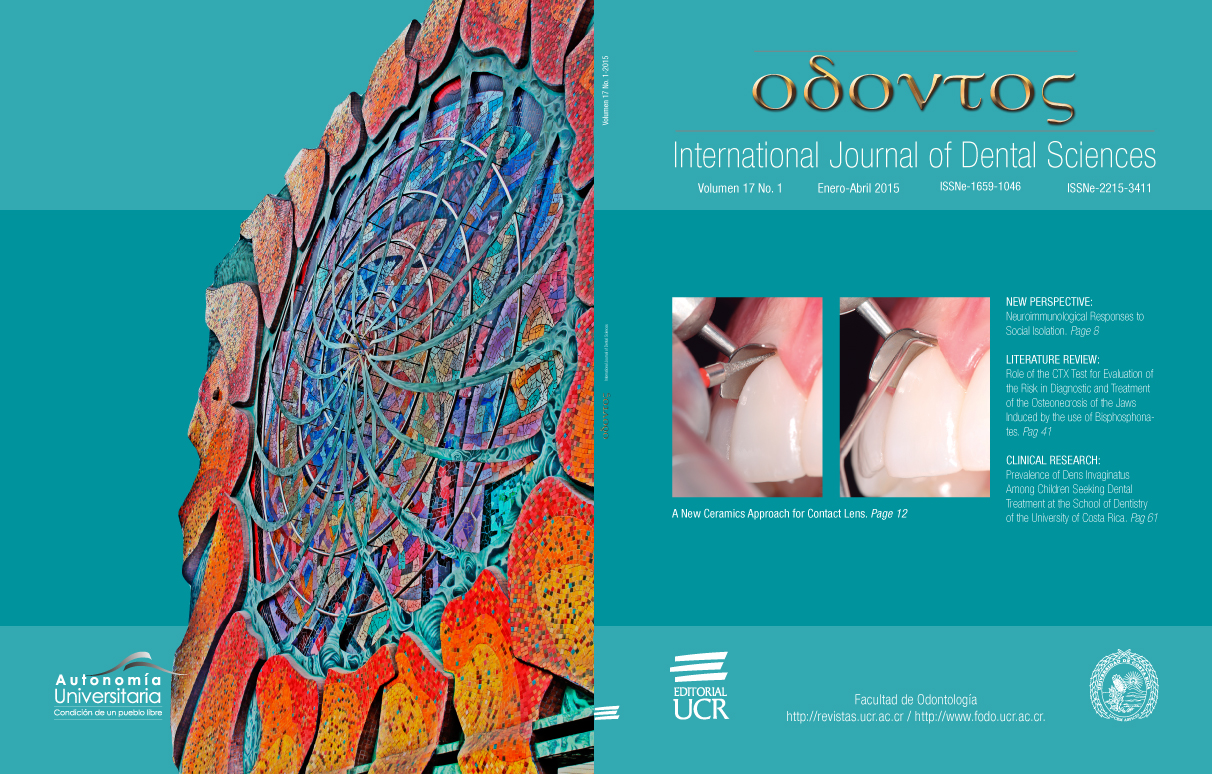Abstract
A literature review was conducted to determine the effectiveness of the C-terminal crosslinking telopeptide (CTX) serologic test, which has been suggested to predict the risk of developing osteonecrosis of the jaw in patients taking oral bisphosphonates. Osteonecrosis of the jaw (ONJ) is a condition that causes avascular necrosis of the alveolar bone, which occurs in patients treated with bisphosphonates. It has been suggested that a CTX value below 100 pg/ml represents a high risk for ONJ , while between 100 and 150 pg / ml a moderate risk and above 150pg/ml minimal risk. The CTX test has been controversial and it has not been possible to frame it as strong evidence, since several studies have found variable results. Patients with very low CTX levels have not developed ONJ, and others with very high CTX levels, supposedly safe, have done . CTX test is a useful test to inform the dentist about the activity level on patient ́s bone turnover, and may be useful to advise the patient. Low CTX levels could serve to delay a surgical procedure that is not deemed urgent.
References
Marx R., Cillo J. Jr , Ulloa JJ. Oral bisphosphonate-induced osteonecrosis: risk factors, prediction of risk using serum CTX testing, prevention, and treatment. Journal of Oral and Maxillofacial Surgery, Dec 2007; 65(12): 2397-2410.
Marx R.E., Sawatari Y, Fortin M, Broumand V. Bisphosphonate-induced exposed bone (osteonecrosis/ osteopetrosis) of the jaws: Risk factors, recognition, prevention, and treatment. Journal of Oral and Maxillofacial Surgery, 2005; 63, 1567.
Assael LA. Serum CTX to prevent osteonecrosis/orthodontic extraction of third molars: paths toward minimizing surgical risk?. Journal of Oral and Maxillofacial Surgery, (Dec-2007;65(12): 2395-2396.
O'Connell J.E., Ikeagwani O, Kearns G.J. A role for C-terminal cross-linking telopeptide (CTX) level to predict the development of bisphosphonate-related osteonecrosis of the jaws (BRONJ) following oral surgery?. Irish Journal of Medical Science, Jun-2012; 181(2): 237-242.
Pasoff M. C-Terminal Cross-Linking Telopeptide as a Serologic Marker for Bisphosphonate-Related Osteonecrosis of the Jaw: Review of 2 Cases. Journal of the Canadian Dental Association, (2013). 1-11.
Sawatari Y., Marx R. E. Bisphosphonates and Bisphosphonate Induced Osteonecrosis. Oral Maxillofacial, Surgical Clinics of North America Journal, 2007; 19: 487–498.
Lazarovici T.S, Mesilaty-Gross S., Vered I., Pariente C., Kanety H., Givol N,. Yahalom R., Taicher S., Yarom N. Serologic bone markers for predicting development of osteonecrosis of the jaw in patients receiving bisphosphonates. Journal of Oral and Maxillofacial Surgery, Sep-2010;68(9): 2241-2247.
Lee C.Y, Suzuki J.B. CTX biochemical marker of bone metabolism. Is it a reliable predictor of bisphosphonate-associated osteonecrosis of the jaws after surgery? Part I: biological concepts with a review of the literature. Implant Dentistry, Dec-2009;18(6): 492-500.
Kunchur R, Need A, Hughes T, Goss A. Clinical investigation of C-terminal cross-linking telopeptide test in prevention and management of bisphosphonate-associated osteonecrosis of the jaws. Journal of Oral and Maxillofacial Surgery, Jun-2009; 67(6): 1167-1173.
Ruggiero S.L., Dodson T.B., Assael L.A., Landesberg R, Marx R.E., Mebrotra B. American Association of Oral and Maxillofacial Surgeons position paper on bisphosphonate- related osteonecrosis of the jaws. Journal of Oral and Maxillofacial Surgery, 2009; 67, 2.
Borromeo G.L, C.E Tsao, I.B Darby, P.R Ebeling. A review of the clinical implications of bisphosphonates in dentistry. Australian Dental Journal, 2011; 56: 2–9.
Mavrokokki T, Cheng A, Stein B, Goss A. Nature and frequency of bisphosphonate-associated osteonecrosis of the jaws in Australia. Journal of Oral and Maxillofacial Surgery, 2007; 65: 415-423.
Dodson T.B. CTX and its role in managing patients exposed to oral bisphosphonates. Journal of Oral and Maxillofacial Surgery, Feb-2010; 68(2): 487-488.
Khosla S, Burr D, Cauley J, Dempster D.W, Ebeling P, Felsenberg D, Gagel R. Oral bisphosphonate-induced osteonecrosis: Risk factors, prediction of risk using serum CTX testing, prevention, and treatment. American Society for Bone and Mineral Research Task Force on Osteonecrosis of the jaw. Journal of Oral and Maxillofacial Surgery, (2008); 66, 1320.
Reynag B., Zeni S. Marcadores bioquímicos del remodelamiento óseo. Utilidad clínica Acta Bioquímica Clínica Latinoamericana, Abril-Junio 2009; 43 (2): 177-193.
Cons F. Marcadores Bioquímicos de Remodelado Óseo. Revista de Metabolismo Oseo y Mineral, 2003;1(3): 91-98.
Schwartz H.C. Serum CTX testing. Journal of Oral and Maxillofacial Surgery, Jun-2008; 66(6): 1319-1320.
Bagan J.V., Jiménez Y., Gómez D., Sirera R., Poveda R., Scully C. Collagen telopeptide (serum CTX) and its relationship with the size and number of lesions in osteonecrosis of the jaws in cancer patients on intravenous bisphosphonates. Oral Oncology, Nov 2008; 44(11).
Kwon Y., Kim D., Ohe J., Yoo J., Walter C. Correlation between serum C-terminal cross-linking telopeptide of type I collagen and staging of oral bisphosphonate-related osteonecrosis of the jaws. Journal of Oral and Maxillofacial Surgery, Dec- 2009; 67(12): 2644-2648.
Lazarovici T.S., Yahalom R., Taicher S., Elad S., Hardan I., Yarom N. Bisphosphonate-related osteonecrosis of the jaws: A single-center study of 101 patients. Journal of Oral and Maxillofacial Surgery, 2009;67: 850-855.
Lee C.Y. CTX biochemical marker of bone metabolism. Is it a reliable predictor of bisphosphonate-associated osteonecrosis of the jaws after surgery? Part II: a prospective clinical study. Implant Dentistry, Feb-2010;19(1): 29-38.
Avolio G., Brandão C., Marcucci M., Alonso G. Use of the plasma CTX for assessing the bone activity of the mandible among osteopenic and osteoporotic patients. Brazillian Oral Research, 2010; 24(2): 250-255.

